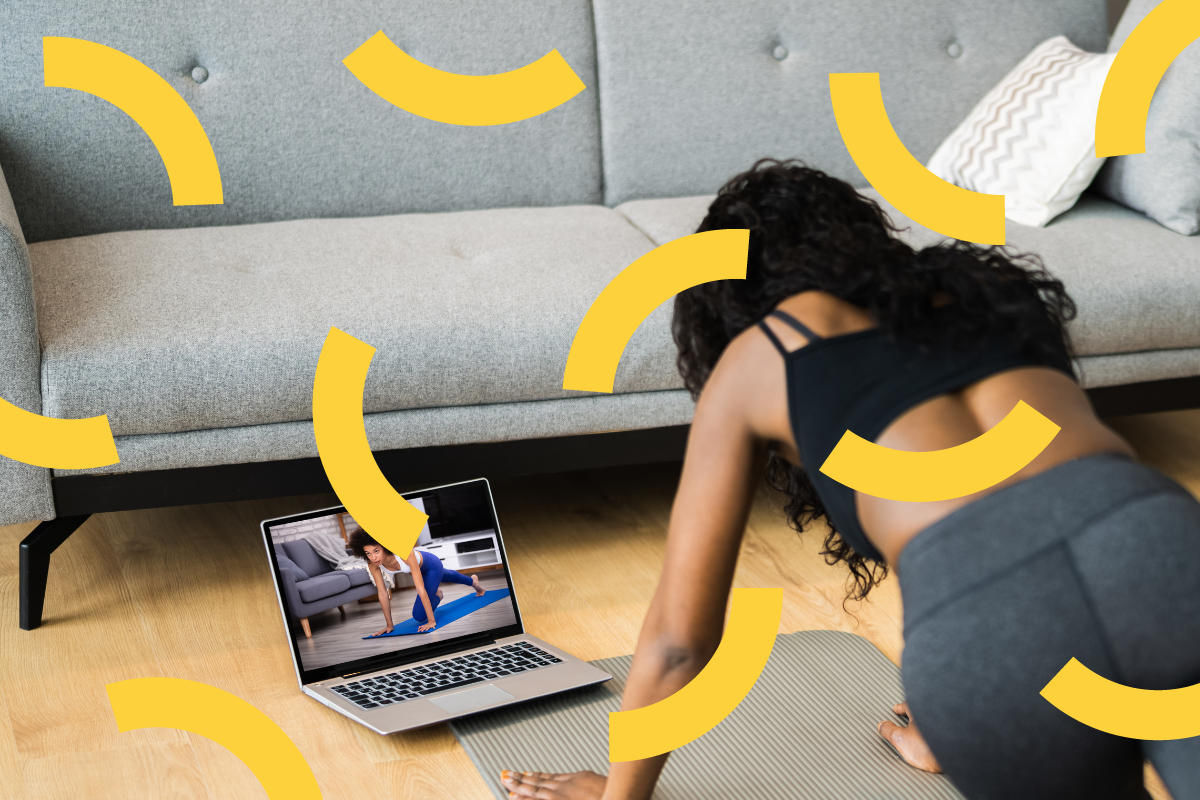
Looking for tips on how to get more personal training clients? These 7 proven tips will help you grow your fitness business.
Online fitness is booming, and many gym owners and personal trainers are reaching clients far beyond their cities with engaging at-home classes. But with online fitness classes still being relatively new, at one point or another, every instructor has asked themselves: what are people looking for in online fitness classes?
Knowing what people are looking for is the difference between low turn-out in your live streamed and on-demand classes, so it’s worth learning. At Trainerize, our goal is is to help gyms and trainers blend online and IRL fitness.
So let’s break down what people are looking for in online fitness classes—and ways you canmatch the demand with your fitness programming to help your clients meet their fitness goals.
🔗 Learn to use video coaching for your online fitness classes!
GET THE FREE GUIDE
7 things people are looking for in online fitness classes
1. Flexibility
Going to a gym or studio requires your clients to leave the house, and for many people, that’s a big ask. Offering high value classes online is a great way to help people create a fitness routine around their busy schedule.
When you’re marketing your online fitness classes, make sure to allude to the time-saving benefits of working-out at home. Lines like “squeeze in that workout you need—even if you’re busy” work well because they’re friendly, and drive home the accessibility you’re offering.
2. High-quality learning
There’s a few key factors that go into creating a high-quality learning experience. These include your background, your lighting, your audio, your internet connection, and of course, your expertise.
So grab some affordable lights for online fitness classes, clean your house, and put some nice art in the frame and upgrade your wifi if it’s a bit spotty, so you never drop off mid-class. Every bit of effort goes a long, long way.
3. Access to the pros
Every neighborhood gym has a trainer or two on-staff, but many people want to train with the very best. Online fitness classes are the easiest way to access quality trainers, and if you position yourself as one, your star power can translate into jam-packed classes.
You don’t have to be Tony Horton to market yourself as a pro. You could be an expert community-builder, or an ex-coach who focuses on a specific sport—like soccer. Maybe you run one of the only fitness classes for BIPOC in your area and specialize in creating inclusive community spaces.
Everyone’s an expert at something, so reflect on what makes you special and double down on it. That narrative will take you further than you could ever imagine.
4. Simple, easy sign-ups
Easy registration is a key part of offering flexible classes, and signing up for an online class shouldn’t feel like a Mission Impossible sequel. People want to be able to register in a few clicks, get an invite link, and then show up to work out.
Getting new clients signed up is a piece of cake with Trainerize. Grab a potential client’s email, then head into your Trainerize web app and add them as a new client. Once they’ve set up their account and logged into the app, they’ll be able to access your classes anytime they like.
5. Workouts you don’t need (much) equipment for
Most of us don’t have dedicated workout spaces at home, and offering workouts that use little equipment is a great way to make sure your classes are accessible to all. If someone can slap down a yoga mat or grab a resistance band and participate fully, you’re in the sweet spot.
That doesn’t mean your live classes will be restricted, though. Calisthenics, plyometrics, and yoga are great workout formats for low-equipment setups, and there’s tons of space within these disciplines to apply your own expertise. (Plus, you can use low-equipment classes to nudge people towards in-person training with all your normal gear.)
Once you’ve got regulars, feel free to incorporate some equipment like resistance bands and medicine balls. They won’t take up much space in a client’s home, and they can open up many more ways to train.
6. Variety
People love new fitness challenges as much as they love mastering a specific workout. So play your greatest hits in your online classes, but remember to keep it fresh. Striking the right balance will help your regulars feel confident and excited about every class.
When you’re running promos, emphasize the new training you’re offering each week, so each class sounds just a tiny bit exclusive. “Join us for two new quad-sculpting exercises” is way more enticing than “let’s do 45 minutes of squats,” you’ve got to admit.
7. Affordable classes
Affordability is another key part of the value people are looking for from online fitness classes. You don’t have to rent fitness studio, you don’t have to commute, and you don’t have any limits on the number of clients you can train at once, so people expect a discount over in-person fitness.
Switching to online doesn’t mean you’ll lose money, though. In fact, it can mean the exact opposite. With less overhead, no limits on participation, and an attractive training offer, you can earn even more than you would in-person. That’s a game-changer.
Pros of online fitness classes
There are tons of pros of online fitness classes.
The convenience and flexibility of online fitness are hard to beat, and they’re why many people are seeking training online. Introverts who might feel nervous in group settings or those with gym anxiety (a.k.a. gymtimidation) can dive in with their cameras turned off, and busy professionals can slot some much-needed exercise into their hectic workdays.
Plus, your clients aren’t limited by what’s on-offer at their local gyms. When they’re shopping for virtual classes, they can cherry-pick the exact routines and trainers they’d like to work with. In-person classes simply can’t compete on that level.
Last, the affordability of switching to online fitness classes makes them accessible for folks of all income brackets. Monthly gym memberships and hourly trainers’ fees aren’t cheap, and offering online fitness classes can give you access to broader audiences than you’d get at a ritzy gym.
You’ll be performing a valuable public health function and strengthening your training business, all at once. Bringing your purpose and profit together feels amazing, too—it’s what keeps us trainers going.
Cons of online fitness classes
Online fitness classes aren’t without their drawbacks, though.
Working out at home is well, working out at home. If your clients have distracting roommates, a cramped room, pets who like to join in, or a chaotic multi-generational living setup, they might crave the escape of in-person training. Virtual fitness classes delivered through Trainerize are super convenient, but meeting up IRL can offer a cure to cabin fever.
Furthermore, in-person classes give trainers better chances to spot issues in form and technique—which can result in injury or hinder progress. By offering in-person training, you also form deeper, more personal relationships with clients. This is key to keeping their business in the long-term.
Offering a hybrid mix of virtual and in-person training gets you the best of both worlds. And not to be too blatant, but we can help you do that. Trainerize makes it easy to deliver online classes, schedule in-person training with your clients, and then offer fitness recommendations, all through one app.
You’ll blend both fitness experiences and keep your clients happy for years to come. Boom.
The best online fitness classes to start with
The best online fitness formats deliver all the things people want, including accessibility, affordability, and novelty. Niche fitness formats pop up all the time, but there’s some classics that never get old. Here’s five online fitness classes that are always in style:
1. Pilates
Pilates workouts are low-impact, and work to strengthen muscles while improving mobility and posture. They can be taught equipment-free, and are a great way to appeal to a broad audience.
2. Cardio Boxing
Want to make your clients sweat? Lead a cardio boxing class and you’ll get their heart rates racing in no time. (Plus, they’ll feel extra self-confident after throwing some jabs and right hooks.)
3. Yoga
Slow it right down and walk your clients through some classic yoga flows—right from the comfort of their own homes. Yoga workouts require no equipment besides a mat (or carpet) and are accessible for athletes of all ages and skill levels.
4. Plyometrics
Pushups, planks, and squats all have one thing in common: you can make them hard with nothing but body weight. That’s the defining feature of plyometrics workouts, which shun equipment in favor of gravity. They’re ultra-accessible, and a great option for online fitness.
5. Dance
Dance isn’t just good for the body—it’s good for the soul as well. Whether you’re leading your clients through hip-hop routines or breaking down the basics of salsa dancing, you’ll provide a good time and a killer workout.
Now that you’ve made it this far, you know everything that people are looking for in their online fitness classes, the most important online fitness formats, and some core value props to emphasize in your marketing.
To start offering your own online fitness classes, fire up the Trainerize app. You’ll be able to create appointment times for your video training sessions, invite your clients, and upload your very own on-demand classes. Soon, you’ll have a library of classes and a bustling training schedule.
In other words, you can have your macro-tracked quinoa salad and eat it too. That’s seriously powerful—and how you’ll hit all your business goals as a trainer.

